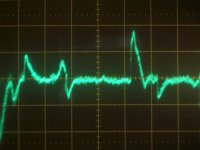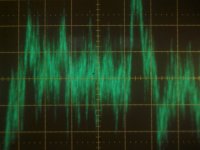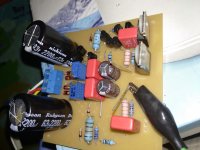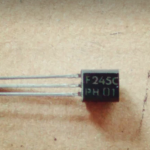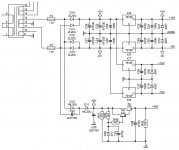Good point. Possibly regulated, for fine trimming of output voltage.Suggest you replace the 'noisy' zener with a voltage source
Zeners are not 'noisy' .
Yes they are, especially if operated with very low current compared to their maximum
current, Pz/Iz. Zener diodes over about 6V are actually avalanche devices.
Zeners in this and other applications can be paralleled with a suitable cap.
A capacitor directly across a Zener diode does little to filter its noise, due to the diode's low
source impedance. A series resistor is needed to build up the source impedance to make
the capacitor effective (RC filter).
Anyways, I do not like the concept of a 'Class A' regulator as suggested. It has two drawbacks:
a). Fixed ceiling for max. possible current delivered to load, determined by a non-variable CCS;
b). Any and all current / energy that is NOT used by the load is simply wasted / shunted and converted into heat
c). Such regulators tend to have a positive (albeit miniscule) output impedance.
There is a way to circumvent the above mentioned drawbacks, by means of a push-pull regulator, or series-shunt regulator with forked feedback loop. The only side circumstance is the need for an additional pot for series/shunt arbitrage.
a). Fixed ceiling for max. possible current delivered to load, determined by a non-variable CCS;
b). Any and all current / energy that is NOT used by the load is simply wasted / shunted and converted into heat
c). Such regulators tend to have a positive (albeit miniscule) output impedance.
There is a way to circumvent the above mentioned drawbacks, by means of a push-pull regulator, or series-shunt regulator with forked feedback loop. The only side circumstance is the need for an additional pot for series/shunt arbitrage.
This is an old myth and simply not true, you can check it out yourself with a simple resistor ZenerA capacitor directly across a Zener diode does little to filter its noise, due to the diode's low
source impedance.
setup and test with and without suitable capacitor.
Anyways, I do not like the concept of a 'Class A' regulator as suggested. It has two drawbacks:
a). Fixed ceiling for max. possible current delivered to load, determined by a non-variable CCS;
b). Any and all current / energy that is NOT used by the load is simply wasted / shunted and converted into heat
c). Such regulators tend to have a positive (albeit miniscule) output impedance.
There is a way to circumvent the above mentioned drawbacks, by means of a push-pull regulator, or series-shunt
regulator with forked feedback loop. The only side circumstance is the need for an additional pot for series/shunt arbitrage.
This is the whole concept of a parallel / shunt regulator and some of the most popular regulators in this forum are of the shunt type.
A, B) If you know the load consumption it is easy to make the ccs current only a little bit larger for low energy waste.
C) The output impedance should always be positive (albeit low), because negative internal resistance means tendency for oscillation.
This is an old myth and simply not true, you can check it out yourself
with a simple resistor Zener setup and test with and without suitable capacitor.
Here is a research paper on this "old myth". There are many more.
http://mirror.thelifeofkenneth.com/lib/electronics_archive/Noise_Behaviour_of_Zener_Diodes.pdf
Last edited:
Summary of the article "Noise Behaviour of Zener Diodes"
.. referenced in post 170 http://mirror.thelifeofkenneth.com/lib/electronics_archive/Noise_Behaviour_of_Zener_Diodes.pdf
If "there are many more" please let us know.
".. study of the phenomenon of noise in Zener diodes in greater detail."
".. noise from Power supplies .. noise in the voltage reference."
Very low frequencies of a few Hz are not investigated.
Zener effect below 6V, relatively high internal resistance of 100 .. 400Ω.
Avalanche diodes of 6V and higher: lower internal resistance, 30 .. 200Ω
and even less with higher currents, 5 .. 20Ω.
Test setup with a 4,3V Zener created a noise level over current curve
touching the test equipment noise limit of 20μV at around 0,2mA: Fig.2
(probably the noise threshold is too high?), but note that the bandwidth
is 15MHz - not too useful for DIY Audio.
Noise values can differ "by powers of ten" even using diodes from the
same source. I think this statement is dubious.
Noise behaviour is different for Zener and Avalanche diodes.
Sometimes chaotic relationship between current and noise observed.
Noise spectrum varies with choice of diode and current.
Description of the test set up in Fig. 1 which is relatively simple.
"Even the first experiments showed that the internal noise resistance
of the Zener diodes was only a few ohms. This confirmed a fact well-
known from experience, that the direct parallel wiring up of a capacitor
alters the noise of a Zener only a little. The source impedance is just
too low!"
Apparently he did not check this again. In the next post I will show it
is not true ..
Avalanche diodes were also tested and show inconsistent results.
Noise limit of the set up does not allow checking the low noise of LEDs.
Etc. ..
All in all this is not a scientific report, but a nice summary of testing some
sample diodes with an experimental test set up.
.. referenced in post 170 http://mirror.thelifeofkenneth.com/lib/electronics_archive/Noise_Behaviour_of_Zener_Diodes.pdf
If "there are many more" please let us know.
".. study of the phenomenon of noise in Zener diodes in greater detail."
".. noise from Power supplies .. noise in the voltage reference."
Very low frequencies of a few Hz are not investigated.
Zener effect below 6V, relatively high internal resistance of 100 .. 400Ω.
Avalanche diodes of 6V and higher: lower internal resistance, 30 .. 200Ω
and even less with higher currents, 5 .. 20Ω.
Test setup with a 4,3V Zener created a noise level over current curve
touching the test equipment noise limit of 20μV at around 0,2mA: Fig.2
(probably the noise threshold is too high?), but note that the bandwidth
is 15MHz - not too useful for DIY Audio.
Noise values can differ "by powers of ten" even using diodes from the
same source. I think this statement is dubious.
Noise behaviour is different for Zener and Avalanche diodes.
Sometimes chaotic relationship between current and noise observed.
Noise spectrum varies with choice of diode and current.
Description of the test set up in Fig. 1 which is relatively simple.
"Even the first experiments showed that the internal noise resistance
of the Zener diodes was only a few ohms. This confirmed a fact well-
known from experience, that the direct parallel wiring up of a capacitor
alters the noise of a Zener only a little. The source impedance is just
too low!"
Apparently he did not check this again. In the next post I will show it
is not true ..
Avalanche diodes were also tested and show inconsistent results.
Noise limit of the set up does not allow checking the low noise of LEDs.
Etc. ..
All in all this is not a scientific report, but a nice summary of testing some
sample diodes with an experimental test set up.
Last edited:
Zener string de-noised by means of a cheap cap ..
I spent some hours on the weekend to build a camera fixture for use with
my oscilloscope, because what is more instructive than a good example?
Test bed is the shunt regulator of an expensive 10 - tube preamp made in
Germany. I built this some time ago to replace the original series regulator
which is overly complicated and prone to failure.
The shunt reg is of the two transistor type: a simple LED referenced current
source of about 80mA and an amplified Zener similar to what you can see in
post 158 here (but no Darlington).
The "Zener" is a string of six 1,3W ZPY51 and ZPY56 with a parallel axial lead
cap 22μF made by Philips - this is about the worst electrolytic cap you can find.
Input voltage is about 380V depending on mains, regulated voltage is 344V.
The first picture shows output noise with Zener cap. Please ignore the charge
current peaks, I suspect some poor ground layout of the preamp is the reason.
The second picture is without this cap. Note the difference. Overload lamp lights.
Scope is Tektronix 7403N with 7A22 high sensitivity amp and 7B53A time base
set to 2ms/div. Vertical sensitivity is 100μV/div. in both cases, single ended input
of this differential amp being used.
HF band limit of the 7A22 was set to 30kHz and high pass to 1kHz in order to
reduce the current pulse noise, the Zener noise with and without cap is affected
by this setting in proportion.
In my view the improvement is impressive. I can show the same with regulators
of low output voltage (made in a similar way) on request.
I spent some hours on the weekend to build a camera fixture for use with
my oscilloscope, because what is more instructive than a good example?
Test bed is the shunt regulator of an expensive 10 - tube preamp made in
Germany. I built this some time ago to replace the original series regulator
which is overly complicated and prone to failure.
The shunt reg is of the two transistor type: a simple LED referenced current
source of about 80mA and an amplified Zener similar to what you can see in
post 158 here (but no Darlington).
The "Zener" is a string of six 1,3W ZPY51 and ZPY56 with a parallel axial lead
cap 22μF made by Philips - this is about the worst electrolytic cap you can find.
Input voltage is about 380V depending on mains, regulated voltage is 344V.
The first picture shows output noise with Zener cap. Please ignore the charge
current peaks, I suspect some poor ground layout of the preamp is the reason.
The second picture is without this cap. Note the difference. Overload lamp lights.
Scope is Tektronix 7403N with 7A22 high sensitivity amp and 7B53A time base
set to 2ms/div. Vertical sensitivity is 100μV/div. in both cases, single ended input
of this differential amp being used.
HF band limit of the 7A22 was set to 30kHz and high pass to 1kHz in order to
reduce the current pulse noise, the Zener noise with and without cap is affected
by this setting in proportion.
In my view the improvement is impressive. I can show the same with regulators
of low output voltage (made in a similar way) on request.
Attachments
You can use any kind of n-channel JFET
hi can you give me the working pcb pdf for this psu?
- Home
- Amplifiers
- Power Supplies
- A-class Preamp PSU
